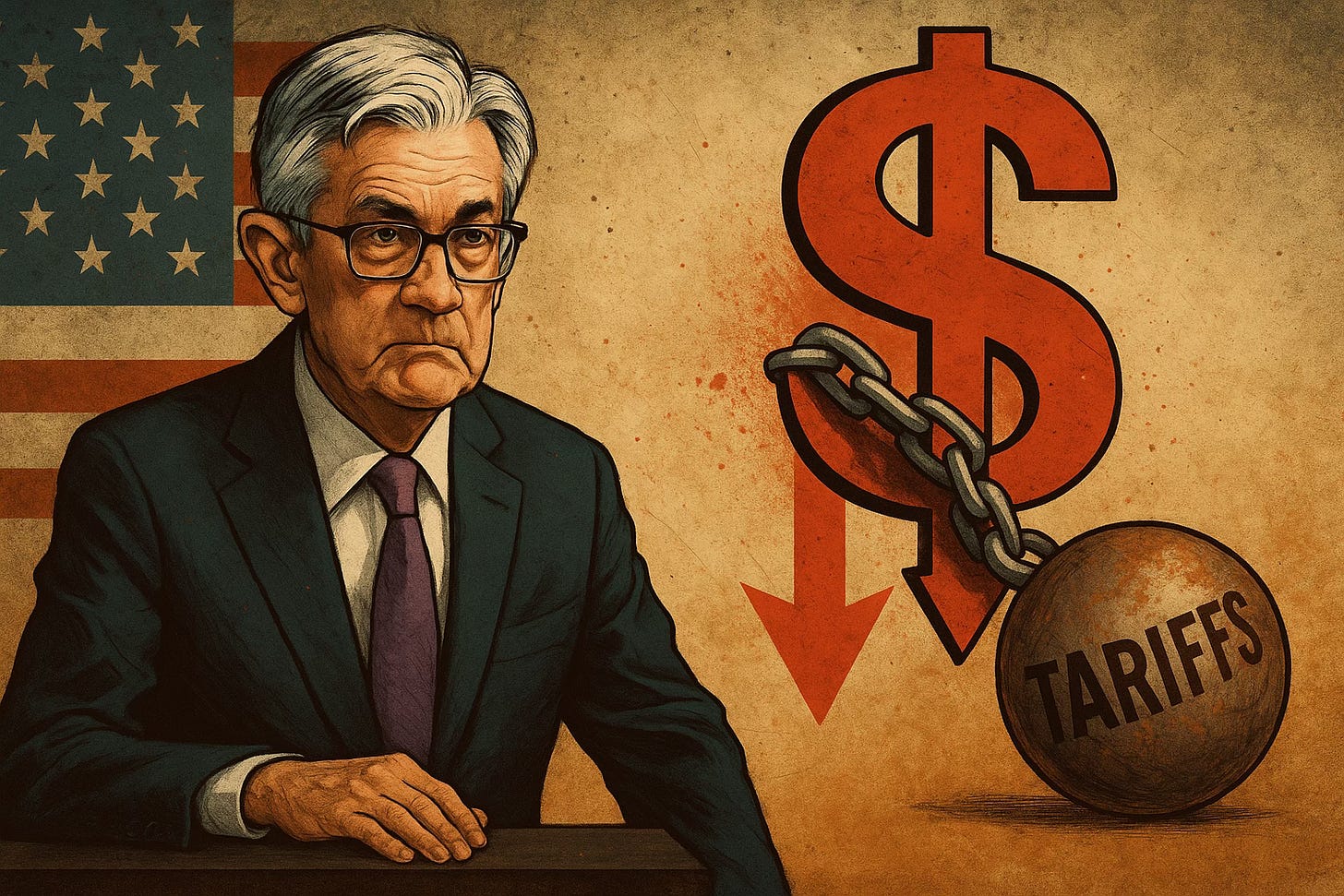Powell Says It Plain: No Tariffs, We Cut
Meeting-by-meeting strategy born from tariff uncertainty
Jerome Powell recently made an unusually candid statement. Speaking in front of global central bankers in Portugal, the Federal Reserve Chair admitted that the Fed would have already cut interest rates if not for Trump’s tariff threats.
There was no technical jargon or vague language. Powell clearly confirmed that U.S. trade policy is now directly influencing the Fed’s decisions on monetary policy.
When asked whether the Fed would have lowered rates without Trump’s tariff plans, Powell replied, “I think that’s right.” This was more than a simple acknowledgment of a delay. It was a direct admission of how deeply Trump’s economic strategy has shaped the central bank’s actions.
Trump’s tariff plan, announced in April, caused inflation forecasts to spike. Powell explained that inflation expectations for the U.S. rose significantly as a result of the tariffs. In response, the Fed decided to hold off on a rate cut.
The scope of the tariff package is extensive. It includes a standard 10 percent levy on nearly all countries and much higher rates, reaching 25 percent or more, for countries with large trade surpluses with the United States. The broad application of these tariffs created significant inflationary pressure, limiting the Fed’s ability to act.
The market responded swiftly. The April announcement triggered a global selloff. This forced the Trump administration to delay the harshest tariffs for 90 days in an attempt to stabilize markets.
That delay is set to expire in early July. Investors see it as a major risk that could lead to further volatility.
The temporary pause gave equities room to recover. The S&P 500 reached new all-time highs. However, underlying uncertainty remains. Investors are cautiously optimistic that negotiations will prevent the most damaging outcomes, but they are well aware that trade policy can change abruptly.
For the Fed, the situation is difficult to manage. If it cuts rates too early, it could accelerate inflation that has already been driven higher by tariffs. If it waits too long, it might miss the opportunity to support a weakening economy.
Powell has adopted a meeting-by-meeting approach to policymaking. This strategy reflects the high level of uncertainty the Fed is now navigating.
Political pressure is compounding the challenge. Trump has launched increasingly personal attacks against Powell. He recently described him as “terrible” and “a very average mentally person.” These comments are not just emotional outbursts. They are attempts to influence the Fed’s policy direction ahead of time.
When asked about his future at the central bank, Powell responded with a carefully neutral comment. He said, “I have nothing for you on that today.” It was widely interpreted as a signal that the pressure from the White House is very real. Trump is believed to be considering replacements. Powell’s term is set to end in 2026.
The uncertainty is clearly reflected in the gold market. Gold prices have surged to $3,341 per ounce, which is more than 43 percent higher than one year ago. This surge is not only a hedge against inflation. It also shows that investors are losing confidence in the stability of current economic policy.
The underlying data supports this cautious outlook. The Tax Foundation estimates that Trump’s tariffs will generate $156.4 billion in federal revenue. This would make them the largest tax increase in decades. However, the Penn Wharton Budget Model paints a more troubling picture. It projects a six percent drop in GDP, a five percent decline in wages, and a lifetime loss of $22,000 for the average middle-income household.
Manufacturing and agriculture have already begun to suffer. Output and employment are falling as businesses struggle with rising input costs and declining global competitiveness. The very industries that the tariffs were meant to protect are now dealing with unintended consequences.
Global growth expectations have also been revised downward. JPMorgan now forecasts just 1.4 percent growth in global GDP by the fourth quarter of 2025. At the beginning of the year, that figure stood at 2.1 percent. The OECD and World Bank have issued similar downgrades, both citing trade tensions as a major factor.
Powell’s admission highlights a critical reality. Monetary policy and trade policy are now deeply interconnected. The Fed can no longer treat trade-related inflation as an external factor, similar to a one-off oil price shock.
In trying to maintain its independence, the Fed has inadvertently revealed just how dependent it has become on political decisions made elsewhere.
The next few months will be an important test. If trade negotiations fail and the full set of tariffs goes back into effect after July 9th, the Fed could find itself dealing with both rising inflation and slowing growth at the same time.
Powell has said that he wants to hand off a healthy economy to his successor. Reaching that goal will require careful navigation between inflation risks and political demands for early rate cuts.
The uncomfortable truth is that U.S. monetary policy is no longer driven solely by economic fundamentals. Trade policy and political calculations now have a direct influence on interest rate decisions.
This shift changes the environment for investors. Interest rate movements can no longer be forecast using economic models alone. Political developments and trade shocks have become equally important variables.
That is one reason why demand for safe-haven assets like gold is so strong.
The traditional separation between fiscal, trade, and monetary policy is breaking down. In its place is a new era of interdependence that makes economic management far more difficult.
Whether the Fed can operate effectively in this new environment, while maintaining credibility, is the question that will define Powell’s legacy. The answer may become clear in the months ahead.


